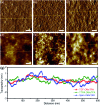3D hole-transporting materials based on coplanar quinolizino acridine for highly efficient perovskite solar cells
- PMID: 29163917
- PMCID: PMC5674323
- DOI: 10.1039/c7sc03543h
3D hole-transporting materials based on coplanar quinolizino acridine for highly efficient perovskite solar cells
Abstract
Over the past five years, perovskite solar cells (PSCs) have gained intense worldwide attention in the photovoltaic community due to their low cost and high power conversion efficiencies (PCEs). One of the most significant issues in achieving high PCEs of PSCs is the development of suitable low-cost hole-transporting materials (HTMs). Here, we put forward a new concept of HTMs for PSCs: a 3D structure with a core of coplanar quinolizino acridine, derived from the conventional concept of 2D triphenylamine HTMs. A cheaper Ag nanolayer was utilized to replace Au as the counter electrodes, and the title HTM TDT-OMeTAD was synthesized via an easy four-step synthesis (total yield: 61%) to achieve the low cost and convenient manufacture of PSCs. Compared with the conventional 2D triphenylamine HTM, TTPA-OMeTPA, PSC devices based on the 3D HTM TDT-OMeTPA showed a significant improvement in PCE from 10.8% to 16.4%, even outperforming Spiro-OMeTAD (14.8%). TDT-OMeTAD's highest PCE mainly results from it having the highest open-circuit voltage (Voc) of 1.01 V in this work, which is proven to be due to the higher hole mobility, matching energy levels, higher hydrophobicity and the smaller dark current. Moreover, an incident photon-current conversion efficiency (IPCE) test and time-resolved photoluminescence (TRPL) have been carried out to observe the better hole injecting efficiency and photoelectric conversion capability of TDT-OMeTPA based PSCs than Spiro-OMeTAD. The TDT-OMeTPA based PSCs exhibited >75% reproducibility (PCE > 15%) and retained 93.2% of the initial PCE after >500 hours.
Figures






Similar articles
-
Defect Passivation by Amide-Based Hole-Transporting Interfacial Layer Enhanced Perovskite Grain Growth for Efficient p-i-n Perovskite Solar Cells.ACS Appl Mater Interfaces. 2019 Oct 30;11(43):40050-40061. doi: 10.1021/acsami.9b13952. Epub 2019 Oct 21. ACS Appl Mater Interfaces. 2019. PMID: 31596062
-
Asymmetrically Substituted 10H,10'H-9,9'-Spirobi[acridine] Derivatives as Hole-Transporting Materials for Perovskite Solar Cells.Angew Chem Int Ed Engl. 2022 Nov 25;61(48):e202212891. doi: 10.1002/anie.202212891. Epub 2022 Oct 25. Angew Chem Int Ed Engl. 2022. PMID: 36200274
-
Dual-Functional Enantiomeric Compounds as Hole-Transporting Materials and Interfacial Layers in Perovskite Solar Cells.ACS Appl Mater Interfaces. 2022 Jun 8;14(22):26135-26147. doi: 10.1021/acsami.2c03025. Epub 2022 May 29. ACS Appl Mater Interfaces. 2022. PMID: 35634977
-
Emerging of Inorganic Hole Transporting Materials For Perovskite Solar Cells.Chem Rec. 2017 Jul;17(7):681-699. doi: 10.1002/tcr.201600117. Epub 2017 Jan 4. Chem Rec. 2017. PMID: 28052541 Review.
-
Hole-Transporting Materials for Printable Perovskite Solar Cells.Materials (Basel). 2017 Sep 15;10(9):1087. doi: 10.3390/ma10091087. Materials (Basel). 2017. PMID: 28914823 Free PMC article. Review.
Cited by
-
Low cost and stable quinoxaline-based hole-transporting materials with a D-A-D molecular configuration for efficient perovskite solar cells.Chem Sci. 2018 Jun 13;9(27):5919-5928. doi: 10.1039/c8sc00731d. eCollection 2018 Jul 21. Chem Sci. 2018. PMID: 30079206 Free PMC article.
-
Synthesis and Investigation of Electro-Optical Properties of H-Shape Dibenzofulvene Derivatives.Molecules. 2022 Feb 6;27(3):1091. doi: 10.3390/molecules27031091. Molecules. 2022. PMID: 35164355 Free PMC article.
-
Synthesis, Properties, and Application of Small-Molecule Hole-Transporting Materials Based on Acetylene-Linked Thiophene Core.Molecules. 2023 Apr 26;28(9):3739. doi: 10.3390/molecules28093739. Molecules. 2023. PMID: 37175149 Free PMC article.
References
-
- Green M. A., Ho-Baillie A., Snaith H. J. Nat. Photonics. 2014;8:506–514.
-
- Meng L., You J. B., Guo T. F., Yang Y. Acc. Chem. Res. 2016;49:155–165. - PubMed
LinkOut - more resources
Full Text Sources
Other Literature Sources
Miscellaneous

